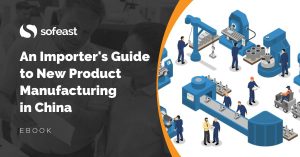You might discover that helping a Chinese factory improve makes sense if you have quality requirements that are challenging to one of the factories you work with, or if you are working with them to develop a complex new product.
Actually, it sometimes makes very good business sense. Spending 10,000 USD might save your company 1 million USD in the end!
And yet, there is a point where you can’t keep “helping” them all the way, as they start to take the habit of being “baby-sat” and they reduce their efforts.
Let’s see an example of how this plays out…
When babysitting a supplier in China goes wrong
A new supplier has trouble understanding, and complying with, your expectations. You send inspectors to give them feedback when they start to produce. It avoids lots of delays and extra costs for you down the road, and it works, as the supplier understands what is important for you.
You keep inspecting their productions, both early and once all is completed. In the beginning, forcing them to re-work the issues immediately has a positive effect, and average quality goes up.
You also see some recurring issues that they seem incapable of fixing on their own. So, you send in engineers who know how to improve the process and set it in a state of statistical control. The factory people learn something. All is good.
After some time, you notice that they rely on your team to detect issues. They don’t really spend time looking at what they are doing when working on your orders. They count on you to deploy resources and help manage production.
Are you feeling the supplier is not holding their end of the bargain? Of course, they aren’t!
You need to think of any new product launch in a given factory as consisting of 3 stages
Stage 1: Getting the first batch right
The more complex the new product, or the wider the gap between what that factory is capable of and your expectations, the more resources you need to pour it at this stage.
Let’s take two extremes.
If you are going to make millions of pieces of the same product or component, you probably want to follow best practices such as the APQP. It involves significant engineering resources upfront, as well as pilot run(s) until the manufacturer has proven that he is ready for mass production. It involves many steps the average Chinese supplier has never heard of, and would never accept.
If you are only placing a one-shot PO to buy promotional T-shirts, just make sure you audit the supplier and you inspect the quality.
Depending on where you fall between these two extremes, think of how you can help your supplier.
Stage 2: Making it repeatable
Let’s say the supplier has shown they can reach your expectations. And they understand your standard.
Now, what? They might still be unable to reach your objectives in a consistent manner. A serious issue might come up every other batch, giving you all sorts of bad surprises.
You need to keep inspecting quality before shipment. Maybe also earlier, during production, to catch mistakes early. Do this until you have a sufficient history to make a better decision.
Little by little, you should make sure the factory takes the relay. You might start to make them feel financial pain when they make a mistake. You might start to require them to do self-inspections and send you their reports. Get them used to being made accountable!
One trick you might use is this:
- Use one team for the final inspections. If problems are found, make it stressful for the factory. This is the way you keep the pressure on at all time.
- If more help is needed, or if inspections during production are still needed, send another team. This team can be nice, give advice, and so on. But it might not come every time. And, if practical, make your supplier pay for this “service”. This is how the supplier understands they shouldn’t get used to relying on your help.
Stage 3: Mature, regular production runs
Let’s say you have received 5 batches of the same product from the same factory. The first one was seriously unacceptable, but then the next 4 were generally fine. A ‘light’ final random inspection might be well suited for this situation.
And, as you reach 10 passed shipments in a row, a ‘random skip lot’ policy (not inspecting every batch) might make sense. Or even discontinuing QC inspections altogether.
What if 40% of shipments have to be reworked? That’s quite a different situation. You need to keep a significant presence to catch those issues. And you might go back to helping the factory — but in other ways. Here are a couple of suggestions:
- Stick & carrot — you offer your supplier two options. Option 1 is they work with consultants that they pay, their performance improves, and they get more business as a reward; option 2 is they do nothing, their performance remains substandard, and they will lose the business soon.
- Help and charge — option 2 is you do the work of identifying the source of the issues and drawing an action plan, come back and audit progress on those issues, and charge penalties to the supplier if they don’t follow the action plan. At the same time, make it obvious that you are talking with other factories and you start to ‘prepare’ them as a backup.
—
I hope it helps. Maybe some readers can suggest some ways they have used to reach this objective?
Are you designing, or developing a new product that will be manufactured in China?
Sofeast has created An Importer’s Guide to New Product Manufacturing in China for entrepreneurs, hardware startups, and SMEs which gives you advance warning about the 3 most common pitfalls that can catch you out, and the best practices that the ‘large companies’ follow that YOU can adopt for a successful project.
It includes:
- The 3 deadly mistakes that will hurt your ability to manufacture a new product in China effectively
- Assessing if you’re China-ready
- How to define an informed strategy and a realistic plan
- How to structure your supply chain on a solid foundation
- How to set the right expectations from the start
- How to get the design and engineering right
Just hit the button below to get your copy (please note, this will direct you to my company Sofeast.com):


